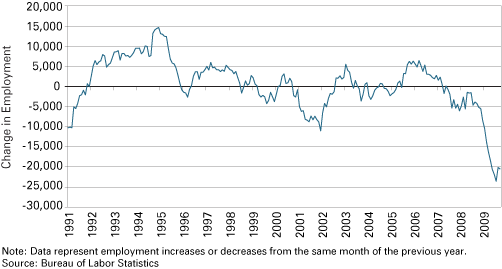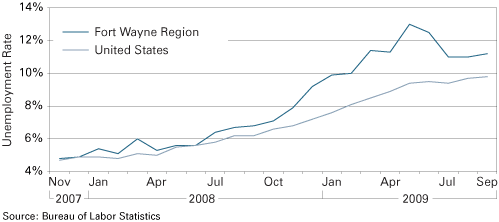Fort Wayne Forecast 2010
Director, Community Research Institute, Indiana University-Purdue University Fort Wayne
November 2009
The causes of this recession were much different than most we have experienced in the past four decades—fueled more by the burst of the housing bubble and a crisis in the financial system rather than a cyclical decline in consumer spending. However, while northeast Indiana had not experienced the unrealistic increase in housing values nor was it in the epicenter of the financial sector, our heavy reliance on manufacturing—particularly in transportation equipment manufacturing—very quickly pulled us in. By mid-summer, many counties in the northeast part of Indiana were experiencing some of the highest unemployment rates in the state, if not the nation.
For purposes of this article, we will define the Fort Wayne region as Adams, Allen, DeKalb, Huntington, Noble, Wells, and Whitley counties. In a few cases, due to data availability, the three-county Fort Wayne Metropolitan Statistical Area (MSA) will be utilized (Allen, Wells, and Whitley counties).
Employment in the Fort Wayne region has now declined compared with the same month of the prior year for twenty-eight consecutive months. One of the real issues is not just how severe but how long this recession will last. Between September 2007 and September 2009, the Fort Wayne region lost nearly 24,800 jobs, nearly as many as in the double-dip recession of the early 1980s. Figure 1 illustrates the magnitude of this recession on northeast Indiana.
Figure 1: Change in Employment for the Fort Wayne Region, 1991 to 2009

On a more positive note, we began to see some areas of economic improvement by the third quarter of 2009. Announcements of business callbacks and expansions have recently been exceeding the number of downsizings and plant closings—both in the number of events reported and in terms of employees affected. For example, General Motors recently announced that it would add 700 jobs to its Allen County facility in the spring of 2010. The Fort Wayne region has also experienced a near 2 percent drop in the monthly (seasonally adjusted) unemployment rate from a high of 13 percent in May to the September rate of 11.2 percent.
The Year Ahead
The difficulty in forecasting what 2010 may bring was epitomized in events of back-to-back days in late October. On October 29, the Dow gained 199 points based on the release of preliminary third quarter gross domestic product (GDP) growth pegged at an annualized rate of 3.5 percent. The next day, the market fell 249 points based largely on the announcement that September consumer spending had dropped 0.5 percent from August. The economy can still be described as fragile at best.
Northeast Indiana remains heavily dependent on the appetite of the American consumer for durable goods. Despite the reduction in manufacturing jobs over the past decade, this region is still far more dependent on the production of goods to generate economic wealth than is the nation. In fact, on a comparative basis, this concentration appears to be increasing. In 1990, the Fort Wayne region had 1.8 times the concentration in manufacturing jobs than the nation. In 2008, this had increased to 2.3 times the national employment concentration in manufacturing employment.1 This concentration in goods production means that the region’s recovery is very dependent upon the level of U.S. consumer spending.
As illustrated in Figure 2, unemployment in the Fort Wayne region jumped substantially beyond national unemployment during the spring and summer of 2009. In recent months, we have seen the gap between the regional and national unemployment rates close somewhat. Certainly, this can be at least partially attributed to some improvement in employment in the automotive and recreational vehicle industries. However, there is no reason to believe that the composition of employment here will allow this gap to narrow further.
Figure 2: Monthly Unemployment Rates, November 2007 to September 2009

From a national perspective, several factors are likely to keep consumer spending down in 2010. Unemployment is predicted to stay around 10 percent for much of the upcoming year. Underemployment has also eroded consumer capacity. Additionally, the negative reaction to the loss of perceived housing wealth (regardless of how artificial this may have been) and to the reduction of retirement portfolios (regardless of how unrealistic some of the prior gains may have been) have and will, in the opinion of this author, continue to dampen consumer spending. Lastly, the lingering tight credit climate carrying over from the financial crisis of 2008 will contribute to constrained spending on durable goods.2
There is considerable evidence to suggest that what we are now experiencing may be more than just the “Great Recession.” We may look back several years from now and call this period the “Great Readjustment.” The psychological impact of the convergence of the housing value free fall in many markets, the dramatic drop in the net worth of baby boomers’ retirement plans, and concern regarding the future financial strength of the federal government to meet all its entitlement obligations without fueling high inflation may nudge American consumers toward saving and away from spending. Going back to the “spend now, save later” approach of the past three decades is not likely to occur soon.
For all of these reasons, it is likely that unemployment in northeast Indiana will remain above the national rate for at least the next year—likely around 1 percent to 1.5 percent above the national rate. For the seven-county Fort Wayne region, this means unemployment is likely to range from 10 percent to 11.5 percent for most of 2010. Employment gains, and there are several signs of encouragement with business expansions, will likely be mostly offset with further business contractions. The two should come close to balancing out. Significant increases in regional employment are likely to have to wait until at least 2011.
One of the issues to watch closely in 2010 will be change in the area’s labor force. We have seen a substantial decline in the number of individuals estimated to be in the labor force over the past three months, averaging 9,200 fewer individuals than were in the local labor force one year earlier. Are individuals becoming discouraged and stopping an active search for work, dropping out of the labor force to go back to school, heading into early retirement, or are they moving from the region?
The Longer-Term Perspective
While the impact of the current recession and the anticipation/desire for a near-term, strong recovery are on the minds of most area residents and employers, we must not lose sight of some longer-term issues that were in play well before the present downturn.
We continue to see a significant restructuring of the regional economy. Mike Jackson, chairman and CEO of Auto Nation, has noted that the automotive industry is currently in a catastrophic situation, but he “remains optimistic about the future because the industry’s old business model of high fixed costs will be destroyed as many companies restructure.”3 That type of restructuring is very much at the heart of changes in the regional economy. In the Fort Wayne metro between 2000 and 2008, average annual goods-producing employment declined by 17.5 percent; service-providing employment increased by 4.6 percent; and total private sector employment declined by 2.3 percent.4
We also continue to lose ground in a relative comparison of key economic indicators:
- Between 1999 and 2008, the Fort Wayne region lost 6.4 percent of its total employment, Indiana lost 1.1 percent and the nation gained 6.2 percent.5
- Between 2001 and 2008, the average annual wage for all jobs grew 15 percent in the Fort Wayne region, 21 percent in the state of Indiana, and 26 percent in the nation. In 2008, the average employee in the Fort Wayne region made 79 percent of the U.S. average annual wage. The potential loss of approximately 1,000 Navistar jobs to the region should their Fort Wayne Design Center relocate to Illinois would only exacerbate this issue.
- Between 2001 and 2008 the growth in GDP for all U.S. metropolitan areas was 17.4 percent after adjusting for inflation. The comparable rate of GDP growth in the Fort Wayne Metropolitan Statistical Area was 7.1 percent. Only the Anderson, Kokomo, and Muncie MSAs had slower GDP growth than did the Fort Wayne MSA over this period.
In many respects, the real issue of concern for northeast Indiana is not the impact of the current recession, but the longer-term trends that we have, to date, been unable to reverse.
Notes
- Based on U.S. Bureau of Labor Statistics Quarterly Census of Employment and Wages data.
- For a more complete discussion of these factors, see the minutes of the Federal Open Market Committee and the Board of Governors of the Federal Reserve System joint meeting on September 22 and 23, 2009.
- William A. Strauss and Emily A. Engel, “Economy to turn corner in 2010,” Chicago Fed Letter, August 2009.
- Based on U.S. Bureau of Labor Statistics Current Employment Statistics data.
- Based on U.S. Bureau of Labor Statistics Quarterly Census of Employment and Wages data.
Also in this Issue…
- Outlook for 2010
- International Outlook for 2010
- U.S. Outlook for 2010
- Financial Outlook for 2010
- Housing Market Outlook for 2010
- Indiana's Outlook for 2010
- Indiana's Agricultural Outlook for 2010
- Anderson Forecast 2010
- Bloomington Forecast 2010
- Columbus Forecast 2010
- Evansville Forecast 2010
- Fort Wayne Forecast 2010
- Gary Forecast 2010
- Indianapolis-Carmel Forecast 2010
- Kokomo Forecast 2010
- Lafayette Forecast 2010
- Louisville Forecast 2010
- Muncie Forecast 2010
- Richmond Forecast 2010
- South Bend and Elkhart Area Forecast 2010
- Terre Haute Forecast 2010




